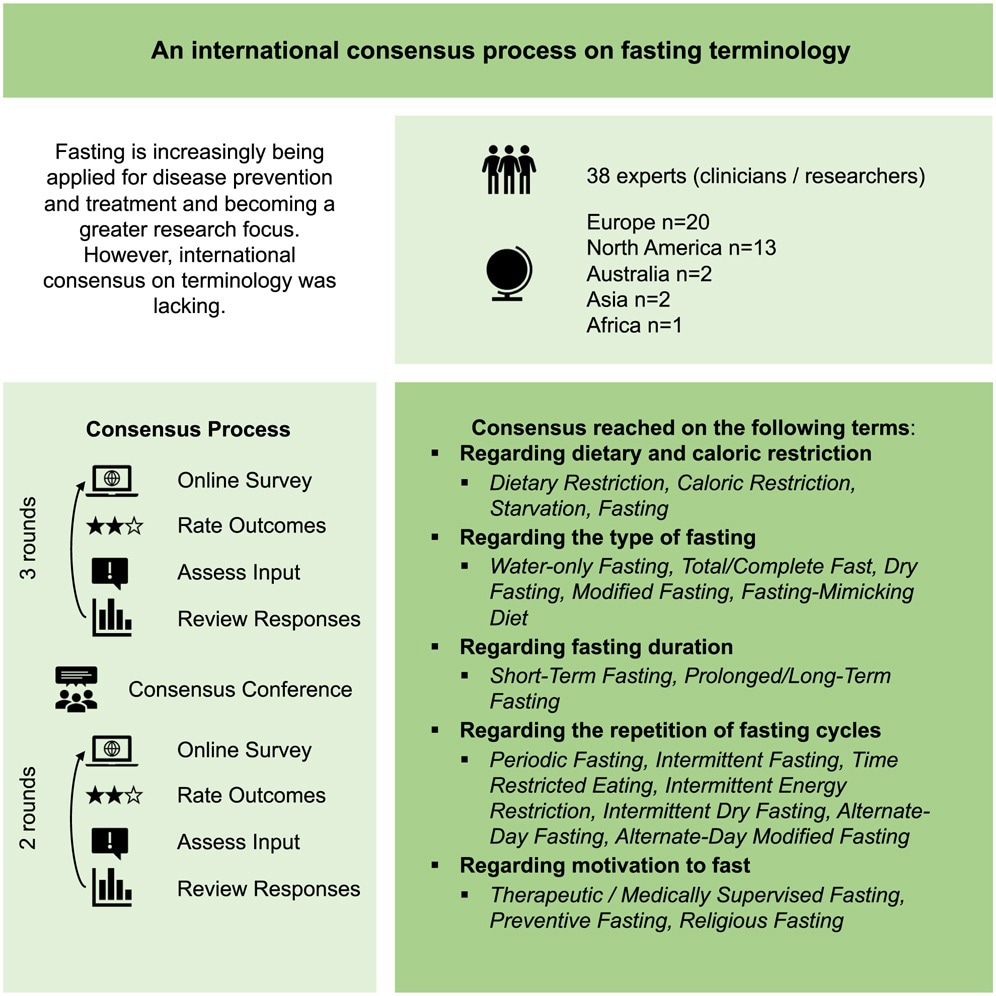The past two decades have witnessed a substantial increase in scientific publications on fasting, such as time-restricted eating (TRE), intermittent fasting (IF), short-term fasting (STF), prolonged fasting (PF), and religious forms of fasting. Animal studies suggest that fasting can prevent and treat diverse chronic diseases. Fasting slows cellular aging processes, extending lifespan. The fundamental physiologic mechanisms of fasting have been well described. Nevertheless, the clinical terminology remains heterogeneous and perplexing.
 International consensus on fasting terminology. Image Credit: vetre / Shutterstock
International consensus on fasting terminology. Image Credit: vetre / Shutterstock
The study and findings
The study presented the first international consensus on fasting terminology, using the Delphi method to achieve this. Initially, 45 experts were invited, and 38 agreed to participate. The survey rounds saw varying levels of completion: 34, 33, 30, 33, and 29 experts participated in each of the five rounds, respectively. In total, 38 experts completed at least one survey, with 25 completing all five rounds. Additionally, 18 experts joined an online conference to discuss the findings further.
In addition, 26 experts participated in a short survey to clarify issues or open questions that emerged during the peer review process. A consensus was reached for 24 proposed definitions. The first survey round, which involved animal-related definitions, suggested developing separate definitions for animal models. As such, it was decided to exclude animal references and limit the terminology to human-relevant definitions at the beginning of the second round.
Initially, possible definitions of caloric restriction included various thresholds of daily minimum or maximum calorie intake while distinguishing from starvation. Nevertheless, the quantitative criteria were dropped, and caloric restriction was broadly defined as a decrease in energy intake below the total calories required to maintain current body weight without resulting in malnutrition.

Graphical Abstract
Many experts agreed to broadly define fasting, encompassing all possible types. Some panelists proposed specifying the motivation for fasting, such as cultural, religious, preventive, or other reasons. As such, fasting was defined as voluntary abstinence from all or some foods alone or with beverages for religious, cultural, preventive, therapeutic, or other reasons.
Modified fasting was referred to as fasting regimens limiting energy intake to up to 25% of energy requirements on modified fasting days. Fluid-only fasting was defined as a modified fasting regimen involving only beverage consumption for a certain period; fruit/vegetable juices and vegetable broth could be consumed up to 500 kcal per day, with ad libitum intake of unsweetened herbal tea and water.
However, ultra-processed fluids should not be consumed. Dry fasting was referred to as voluntary abstinence from all foods and beverages (even water) for a certain period. Further, complete or total fasting was defined as regimens with no calorie intake for a specific period. Experts initially contended to classify fasting-mimicking diets (FMDs) as a modified fasting regimen.
Nonetheless, FMDs were categorized as special fasting regimens and defined as diets inducing the metabolic effects of fasting while allowing a higher caloric intake, with a maximum of 1,000 kcal per day, lasting three to seven days. Intermittent energy restriction (IER), IF, and TRE were discussed under IF regimens. The main point of discussion was the relationship among IF, IER, and TRE.
IER was defined as alternating periods of caloric restriction and ad libitum eating. IF was described as a subcategory of IER and referred to as repetitive fasting for up to 48 hours. Further, TRE was defined as fasting for at least 14 hours a day without explicit energy intake limits during eating hours. The primary discussion points for continuous fasting regimens were to define periodic fasting and distinguish between STF and PF/long-term fasting (LTF).
Experts initially suggested varying periods for STF and PF/LTF durations. However, finally, STF was defined as a fasting regimen lasting 2–3 days, whereas LTF, also called PF, was described as a fasting regimen lasting at least four consecutive days. Further, periodic fasting was defined as any fasting regimen repeated periodically, i.e., at regular intervals, such as daily or weekly.
Conclusions
Taken together, the study developed an international expert consensus unifying fasting terminology in clinical research and practice. The authors believe this would facilitate further high-quality research on fasting on a global scale. They recommend using these definitions to compare methodologies and results. Moreover, at least these definitions are planned for a reassessment in the next five years.